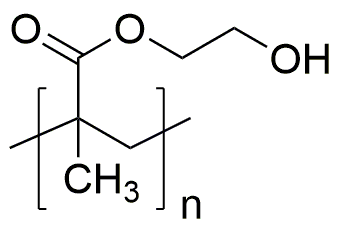Poly(2-hydroxyethyl methacrylate) is widely utilized in research focused on:
- Biomedical Applications: This compound is used to create hydrogels for drug delivery systems, allowing for controlled release of medications in a targeted manner, which enhances therapeutic efficacy.
- Contact Lenses: It serves as a key material in the production of soft contact lenses, providing excellent moisture retention and comfort for users.
- Coatings and Adhesives: The chemical is employed in formulating coatings that offer superior adhesion and durability, making it ideal for various industrial applications.
- Wound Dressings: Its biocompatibility makes it suitable for use in wound dressings, promoting healing while preventing infection.
- Cosmetic Products: It is incorporated into skincare formulations for its ability to create a smooth texture and improve moisture retention, enhancing product performance.
Información general
Propiedades
Seguridad y normativas
Aplicaciones
Poly(2-hydroxyethyl methacrylate) is widely utilized in research focused on:
- Biomedical Applications: This compound is used to create hydrogels for drug delivery systems, allowing for controlled release of medications in a targeted manner, which enhances therapeutic efficacy.
- Contact Lenses: It serves as a key material in the production of soft contact lenses, providing excellent moisture retention and comfort for users.
- Coatings and Adhesives: The chemical is employed in formulating coatings that offer superior adhesion and durability, making it ideal for various industrial applications.
- Wound Dressings: Its biocompatibility makes it suitable for use in wound dressings, promoting healing while preventing infection.
- Cosmetic Products: It is incorporated into skincare formulations for its ability to create a smooth texture and improve moisture retention, enhancing product performance.
Documentos
Hojas de datos de seguridad (HDS)
La SDS proporciona información de seguridad completa sobre la manipulación, el almacenamiento y la eliminación del producto.
Especificación del producto (PS)
La PS proporciona un desglose completo de las propiedades del producto, incluida la composición química, el estado físico, la pureza y los requisitos de almacenamiento. También detalla los rangos de calidad aceptables y las aplicaciones previstas del producto.
Certificados de análisis (COA)
Busque certificados de análisis (COA) ingresando el número de lote del producto. Los números de lote y de partida se pueden encontrar en la etiqueta de un producto después de las palabras "Lote" o "Lote".
Número de catálogo
Número de lote/lote
Certificados de origen (COO)
Este certificado de origen confirma el país en el que se fabricó el producto y también detalla los materiales y componentes utilizados en él y si se deriva de fuentes naturales, sintéticas u otras fuentes específicas. Este certificado puede ser necesario para cumplir con las normativas aduaneras, comerciales y regulatorias.
Número de catálogo
Número de lote/lote
Hojas de datos de seguridad (HDS)
La SDS proporciona información de seguridad completa sobre la manipulación, el almacenamiento y la eliminación del producto.
DownloadEspecificación del producto (PS)
La PS proporciona un desglose completo de las propiedades del producto, incluida la composición química, el estado físico, la pureza y los requisitos de almacenamiento. También detalla los rangos de calidad aceptables y las aplicaciones previstas del producto.
DownloadCertificados de análisis (COA)
Busque certificados de análisis (COA) ingresando el número de lote del producto. Los números de lote y de partida se pueden encontrar en la etiqueta de un producto después de las palabras "Lote" o "Lote".
Número de catálogo
Número de lote/lote
Certificados de origen (COO)
Este certificado de origen confirma el país en el que se fabricó el producto y también detalla los materiales y componentes utilizados en él y si se deriva de fuentes naturales, sintéticas u otras fuentes específicas. Este certificado puede ser necesario para cumplir con las normativas aduaneras, comerciales y regulatorias.


